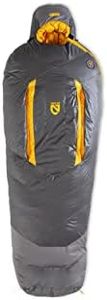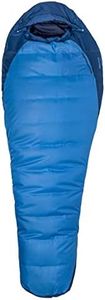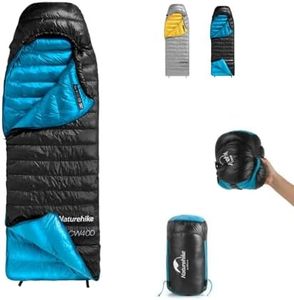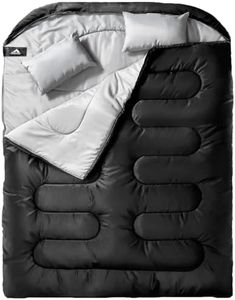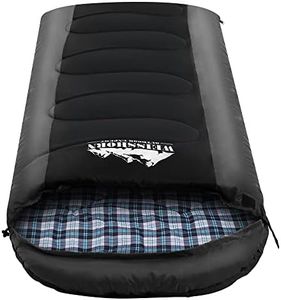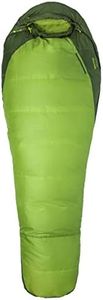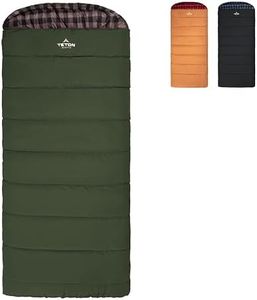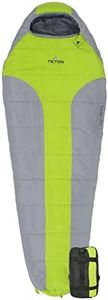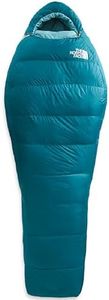We Use CookiesWe use cookies to enhance the security, performance,
functionality and for analytical and promotional activities. By continuing to browse this site you
are agreeing to our privacy policy
10 Best Tall Sleeping Bag
From leading brands and best sellers available on the web.Buying Guide for the Best Tall Sleeping Bag
Choosing a tall sleeping bag is important if you’re above average height or want a little extra room when camping or backpacking. The right sleeping bag should keep you comfortable through the night, fit your body without feeling cramped, and provide the right level of warmth for your outdoor adventures. When shopping, you’ll want to look at several key specifications that will help you find a bag that matches your needs, preferences, and the conditions you’ll encounter.LengthThe length of a sleeping bag determines if it’s suitable for taller individuals, typically those over six feet. Length is crucial because a bag that is too short will leave your feet sticking out or feeling cramped, reducing comfort and warmth. Sleeping bags come in different lengths; standard is usually around 72 inches, while tall models can go up to 78–84 inches or more. If you're tall, choose a bag a few inches longer than your height to ensure comfort; if you’re not as tall but still want extra room, a 'long' size might give you the space you need.
ShapeShape impacts both the comfort and insulation of your sleeping bag. Common shapes include mummy, rectangular, and semi-rectangular. Mummy bags taper towards the feet for better heat retention but can feel snug for taller people with longer limbs, while rectangular bags offer more room to move but may be less efficient at staying warm. If you prioritize warmth and don’t mind a snug fit, a mummy shape might be best, while those seeking extra wiggle-room should consider semi-rectangular or rectangular options.
Temperature RatingTemperature rating tells you the lowest temperature at which the sleeping bag is expected to keep an average person warm. If you sleep cold or camp in cold weather, choose a bag with a lower temperature rating. For summer or mild climates, a higher rated (warmer) bag may be more comfortable. Typical segments are summer/indoor (above 35°F), three-season (20–35°F), and winter (below 20°F). Match the rating with where you plan to camp, and always round down a little if you’re not sure, since you can always vent the bag if too warm.
Insulation TypeInsulation determines how the bag keeps you warm and how light or bulky it is. The main types are down (made from duck or goose feathers) and synthetic. Down is lighter, compresses smaller, and insulates well but costs more and must stay dry to work well. Synthetic doesn’t compress as much but stays warm if wet and is usually easier to clean. Choose down if you need something light for backpacking and expect dry conditions, or synthetic for casual use, damp climates, or ease of care.
WeightWeight matters most if you’ll be carrying the sleeping bag on your back for long periods. Lighter bags are easier to pack and carry, ideal for backpackers, while heavier ones may offer more comfort and features for car camping. Categories are ultralight (under 2 lbs), lightweight (2–3 lbs), and regular (over 3 lbs). Select based on whether you’ll hike with your bag or simply carry it short distances.
Packed SizePacked size refers to how small the sleeping bag becomes when compressed into its storage sack. It’s important for those with limited space, such as backpackers. Smaller packed sizes are easier to fit in a pack but may sacrifice some comfort or warmth. If you need to fit your sleeping bag into a tight space (like a backpack), check the packed dimensions; otherwise, for car camping, this is less of a concern.
Shell and Lining MaterialThe outer shell and inner lining affect durability, comfort, and moisture resistance. Nylon and polyester are most common, with some shells featuring water-resistant coatings. Softer linings feel better against the skin, while durable shells help if you're rough on gear. If you expect wet conditions, look for a high-quality shell with water resistance. For comfort, check that the lining suits your personal preference.
